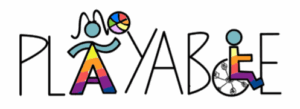PLAYABLE
PLAYABLE – Physical Leisure Activities in Children with and without Disabilities 
An active lifestyle is essential for the healthy development of children (Biddle & Asare, 2011; Janssen & LeBlanc, 2010), as well as for long-term health outcomes in adulthood (Miko et al., 2020). Physical activity and active play not only promote motor skills but also support social interaction, cognitive development (Blinkert, 2015), reduce the risk of chronic and non-communicable diseases, and enhance social inclusion (World Health Organization, 2011).
However, international data indicate that globally, only 40–46% of children engage in more than two hours of active play per day (Aubert et al., 2022). The numbers are even lower among children with disabilities—with fewer than 39% meeting this threshold (Ng et al., 2023). In Germany, findings from the KiGGS study show a decline in free, unstructured play, while participation in extracurricular and organized sports activities is increasing (Schmidt et al., 2016).
Currently, comprehensive and up-to-date data on leisure-time physical activity in primary school-aged children with and without disabilities are lacking. Furthermore, no data are available that systematically examine these prevalence rates in relation to key influencing factors—such as individual (e.g., gender, age, health status), social (e.g., parental support, safety concerns), and physical-environmental factors (e.g., availability of spaces for physical activity). As a result, it remains unclear which conditions promote or inhibit active leisure engagement and where targeted support measures could be implemented.
The PLAYABLE Study
The PLAYABLE (Physical Leisure Activities in Children with and without Disabilities) study addresses these knowledge gaps. The aim is to develop a comprehensive understanding of physical activity behaviors and the relevant influencing factors among primary school children in Germany—both with and without disabilities. The focus is on non-organized active play in indoor and outdoor settings, active mobility (e.g., how children travel from one place to another), and physical activity in organized contexts such as schools, sports clubs, and commercial providers.
A nationwide, representative data collection will be conducted in spring 2025 using online questionnaires completed by parents and their children via the “Forsa Omninet” panel.
The findings of this study are intended to inform the development of targeted strategies to promote active leisure behavior and ensure equal opportunities for all children. The results will provide valuable insights for researchers, policymakers, educators, sports organizations, and parents—with the overarching goal of creating more and better opportunities for physical activity and inclusion.
Project Leads: Prof. Dr. Anne Kerstin Reimers, Prof. Dr. Yolanda Demetriou (University of Tübingen)
Research Team: Dr. Franziska Beck, Dr. Jannika John (University of Tübingen), Selina Seemüller, Jasmin Brecht (University of Tübingen)
Project Duration: 2024–2026
Project Partner: University of Tübingen
Publication List:
References:
Aubert, S., Barnes, J. D., Demchenko, I., Hawthorne, M., Abdeta, C., Abi Nader, P., Adsuar Sala, J. C., Aguilar-Farias, N., Aznar, S., Bakalar, P., Bhawra, J., Brazo-Sayavera, J., Bringas, M., Cagas, J. Y., Carlin, A., Chang, C. K., Chen, B., Christiansen, L. B., Christie, C. J.,…Tremblay, M. S. (2022). Global Matrix 4.0 Physical Activity Report Card Grades for Children and Adolescents: Results and Analyses From 57 Countries. Journal of Physical Activity & Health, 19(11), 700-728. https://doi.org/10.1123/jpah.2022-0456
Biddle, S. J., & Asare, M. (2011). Physical activity and mental health in children and adolescents: a review of reviews. British Journal of Sports Medicine, 45(11), 886-895. https://doi.org/10.1136/bjsports-2011-090185
Blinkert, B. (2015). Residential Environment and Types of Childhood. Humanities and Social Sciences, 3(5). https://doi.org/10.11648/j.hss.20150305.11
Janssen, I., & LeBlanc, A. (2010). Systematic review of the health benefits of physical activity and fitness in school-aged children and youth. International Journal of Behavioral Nutrition and Physical Activity, 7, 40.
Miko, H. C., Zillmann, N., Ring-Dimitriou, S., Dorner, T. E., Titze, S., & Bauer, R. (2020). [Effects of Physical Activity on Health]. Gesundheitswesen, 82(S 03), S184-S195. https://doi.org/10.1055/a-1217-0549 (Auswirkungen von Bewegung auf die Gesundheit.)
Ng, K., Sit, C., Arbour-Nicitopoulos, K., Aubert, S., Stanish, H., Hutzler, Y., Santos Silva, D. A., Kang, M.-G., López-Gil, J. F., Lee, E.-Y., Asunta, P., Pozeriene, J., Urbanski, P. K., Aguilar-Farias, N., & Reilly, J. (2023). Global Matrix of Para Report Cards on Physical Activity of Children and Adolescents With Disabilities. Adapt Phys Activ Q, 40(3), 568. https://doi.org/10.1123/apaq.2023-0047
Schmidt, S., Will, N., Henn, A., Reimers, A., & Woll, A. (2016). Der Motorik-Modul Aktivitätsfragebogen MoMo-AFB.
World Health Organization. (2011). World Report on Disability.